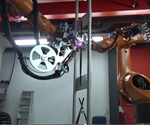Hexcel applies additive manufacturing to unmanned aerial vehicle systems
Hexcel’s HexAM process produces stiff, lightweight and complex components that are often too expensive or impossible to produce.

Pictured is a transition duct for an unmanned aerial vehicle (UAV) made by GA-ASI using Hexcel HexAM additive manufacturing technology. Source | GA-ASI
Hexcel Corp. (Stamford, Conn., U.S.) reported that it has been a key partner with General Atomics Aeronautical Systems (GA-ASI, San Diego, Calif., U.S.) in the development and production of carbon fiber-reinforced thermoplastic components for complex structures on GA-ASI’s unmanned aerial vehicle (UAV)/remotely piloted aircraft (RPA) systems.
“The HexAM process produces stiff and lightweight components that are critical for aerospace systems,” says Larry Varholak, vice president of Additive Manufacturing at Hexcel. “We value our collaboration and work with GA-ASI to develop the components for its UAV/RPA systems that enhance performance while lowering costs.”
Using HexAM technology, Hexcel and GA-ASI are said to have produced several complex geometric components that would otherwise be expensive or impossible to produce with traditional composite, molding, or machining methods. Many of the applications, Hexcel says, are for inner mold line (IML), outer mold line (OML), ducting and manifolds where the complex geometries enabled by additive manufacturing provide design freedom and an easier manufacturing process to improve performance and operation of UAV systems.
Hexcel says in addition to carbon fiber-reinforced polyetherketoneketone (PEKK) which has mechanical and thermal properties that are ideal for UAV/RPA systems, it has also developed bonding methods for larger structures that broaden the component application space that GA-ASI can take advantage of.
“The Hexcel team has helped us enhance our additive manufacturing applications space,” points out Elie Yehezkel, senior vice president of Advanced Manufacturing Technologies at GA-ASI. “We are finding HexAM technology and the additive manufacturing process at Hexcel to have a solid foundation of material data that we can use for design and analysis.”
Yehezkel also notes that through GA-ASI’s engagement with the Hexcel team, the latter have demonstrated their process to be robust, repeatable and capable of producing complex parts and assemblies needed for GA-ASI’s systems. Despite the carbon-filled PEKK HexAM process being thermally challenging, Yehezkel says Hexcel seems knowledgeable at delivering components that can repeatedly meet the company’s dimensional tolerance requirements.
The partnership, Hexcel says, continues to propel new applications for HexAM technology. Grounded with a solid foundation of material properties testing, the teams are now able to move quickly from prototyping to production for new applications for the technology on GA-ASI systems.
Related Content
-
Infinite Composites: Type V tanks for space, hydrogen, automotive and more
After a decade of proving its linerless, weight-saving composite tanks with NASA and more than 30 aerospace companies, this CryoSphere pioneer is scaling for growth in commercial space and sustainable transportation on Earth.
-
Plant tour: Joby Aviation, Marina, Calif., U.S.
As the advanced air mobility market begins to take shape, market leader Joby Aviation works to industrialize composites manufacturing for its first-generation, composites-intensive, all-electric air taxi.
-
The lessons behind OceanGate
Carbon fiber composites faced much criticism in the wake of the OceanGate submersible accident. CW’s publisher Jeff Sloan explains that it’s not that simple.















